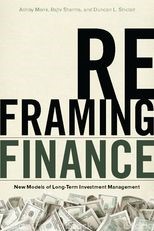Reframing Finance: New Models of Long-Term Investment Management
Reframing Finance: New Models of Long-Term Investment Management
Cite
Abstract
The role of financial intermediaries has come under close scrutiny in recent times as many of the practices of these service firms have been exposed for their opaque, rent-seeking and dishonest behavior. This book questions the traditional system of Financial Capitalism by examining how beneficiary organizations such as pension funds, sovereign wealth funds, endowments and foundations can reduce the inefficiencies of intermediaries in the savings-investment channel. This book argues that the large pools of long-term capital held in beneficiary organizations has not been mobilized efficiently enough into the capital-intensive long-term projects such as infrastructure, green energy, agriculture, private equity and real estate development. In particular, the book examines a new ‘collaborative’ form of investing that a large number of beneficiary organizations have started to embark on in order to address the problem of mainstream financial intermediation and achieve their long-term investment objectives. The book conceptualizes the ‘collaborative’ model of investment, drawing upon economic sociology, and emphasizes the importance for investors to build their social capital. By providing case study exemplars of collaborative vehicles such as co-investment platforms, joint ventures, and platform companies that invest in infrastructure, agriculture, private equity and real estate, the book provides useful insights for how long-term investment management might be shaped in the future.
Sign in
Personal account
- Sign in with email/username & password
- Get email alerts
- Save searches
- Purchase content
- Activate your purchase/trial code
Institutional access
-
Sign in through your institution
- Sign in with a library card Sign in with username/password Recommend to your librarian
Institutional account management
Sign in as administratorPurchase
Our books are available by subscription or purchase to libraries and institutions.
Purchasing information| Month: | Total Views: |
|---|---|
| February 2023 | 3 |
| February 2023 | 1 |
| February 2023 | 1 |
| February 2023 | 2 |
| April 2023 | 5 |
| April 2023 | 4 |
| April 2023 | 2 |
| April 2023 | 1 |
| April 2023 | 4 |
| April 2023 | 2 |
| April 2023 | 4 |
| April 2023 | 4 |
| April 2023 | 2 |
| August 2023 | 6 |
| August 2023 | 6 |
| August 2023 | 5 |
| August 2023 | 1 |
| August 2023 | 5 |
| August 2023 | 3 |
| August 2023 | 5 |
| August 2023 | 6 |
| August 2023 | 3 |
| August 2023 | 8 |
| August 2023 | 3 |
| August 2023 | 6 |
| August 2023 | 6 |
| March 2024 | 1 |
| April 2024 | 2 |
| April 2024 | 3 |
| April 2024 | 2 |
| April 2024 | 2 |
| April 2024 | 3 |
| April 2024 | 3 |



Get help with access
Institutional access
Access to content on Oxford Academic is often provided through institutional subscriptions and purchases. If you are a member of an institution with an active account, you may be able to access content in one of the following ways:
IP based access
Typically, access is provided across an institutional network to a range of IP addresses. This authentication occurs automatically, and it is not possible to sign out of an IP authenticated account.
Sign in through your institution
Choose this option to get remote access when outside your institution. Shibboleth/Open Athens technology is used to provide single sign-on between your institution’s website and Oxford Academic.
If your institution is not listed or you cannot sign in to your institution’s website, please contact your librarian or administrator.
Sign in with a library card
Enter your library card number to sign in. If you cannot sign in, please contact your librarian.
Society Members
Society member access to a journal is achieved in one of the following ways:
Sign in through society site
Many societies offer single sign-on between the society website and Oxford Academic. If you see ‘Sign in through society site’ in the sign in pane within a journal:
If you do not have a society account or have forgotten your username or password, please contact your society.
Sign in using a personal account
Some societies use Oxford Academic personal accounts to provide access to their members. See below.
Personal account
A personal account can be used to get email alerts, save searches, purchase content, and activate subscriptions.
Some societies use Oxford Academic personal accounts to provide access to their members.
Viewing your signed in accounts
Click the account icon in the top right to:
Signed in but can't access content
Oxford Academic is home to a wide variety of products. The institutional subscription may not cover the content that you are trying to access. If you believe you should have access to that content, please contact your librarian.
Institutional account management
For librarians and administrators, your personal account also provides access to institutional account management. Here you will find options to view and activate subscriptions, manage institutional settings and access options, access usage statistics, and more.